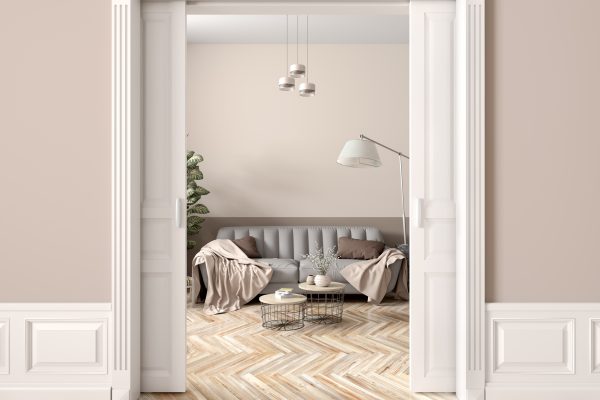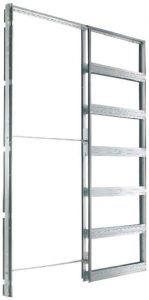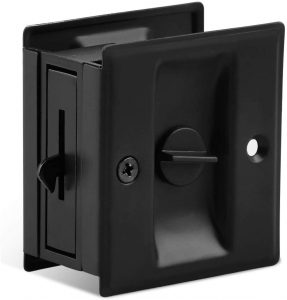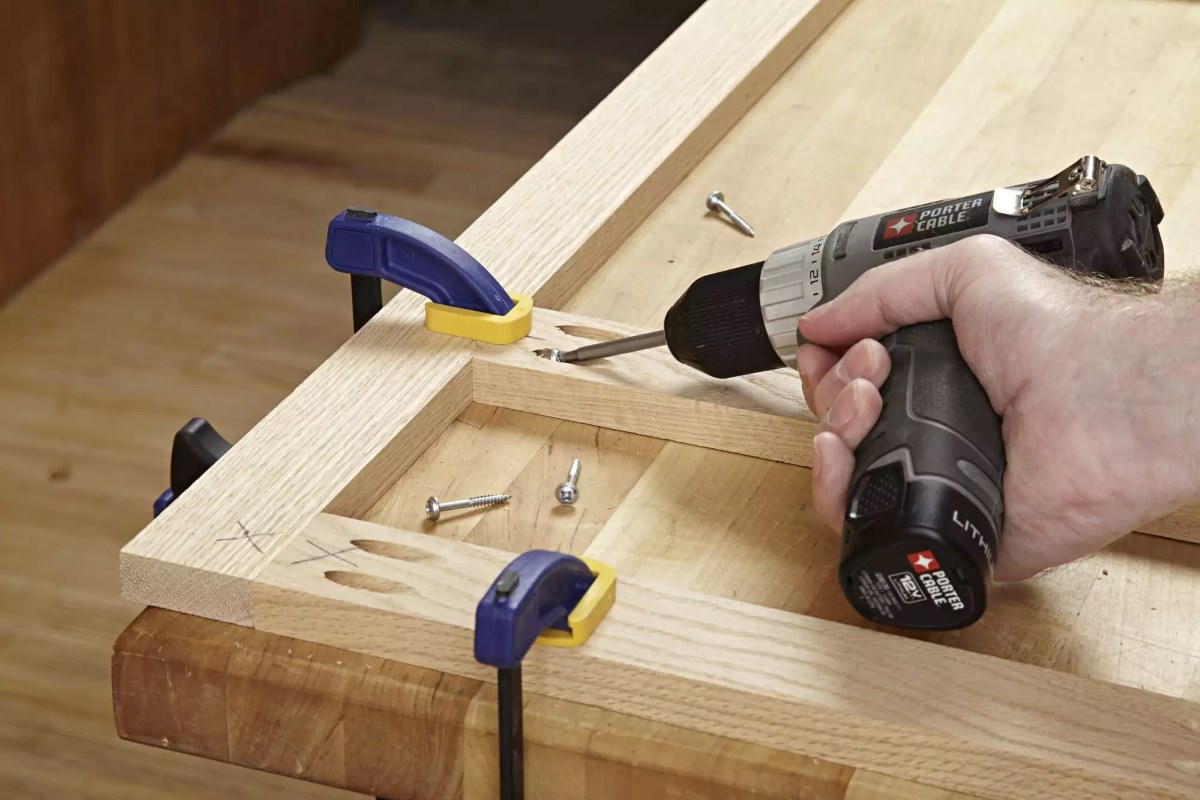Home>Interior Design>What Are Pocket Doors and How Do You Install Them?


Interior Design
What Are Pocket Doors and How Do You Install Them?
Modified: December 6, 2023
Designed with space saving in mind and perfect for any modern home, pocket doors are a prime example of form meets function. Read more about them here!
(Many of the links in this article redirect to a specific reviewed product. Your purchase of these products through affiliate links helps to generate commission for Storables.com, at no extra cost. Learn more)
Any bit of space saved is a big plus in any home. From wall-mounted folding tables to floating desks, homemakers are always on the lookout for ways to keep their rooms nice and spacious. If you’re one of them, we suggest looking at the humble pocket door to take your first step towards a more open home!
What Are Pocket Doors?
Pocket doors function as indoor sliding doors that disappear into the wall when opened. These space-saving doors work in conjunction with a frame that’s built into the wall of the home. There’s a track installed at the top of the frame, and the door hangs from a set of carriers running along this track. The carriers have glider wheels that allow the door to slide open and close with ease. The frame of a pocket door also typically has guides on the bottom that keep the door from bumping into the walls as it slides in and out.
While they are made for small spaces, pocket doors can also make larger spaces feel even bigger. These clever entryways reduce the need to leave empty areas for a traditional door to swing in. The whole mechanism was designed with space-saving in mind.

Read more: How To Lock A Pocket Door
Benefits of Pocket Doors
While pocket doors are more complex than their traditional counterparts, there’s no question that they bring another level of satisfaction. In-wall doors allow all the space they save to be utilized for extra decor, movement, or simply empty pockets that open up a room. The transition from one room into the next is, quite literally, seamless when the pocket door is tucked into the wall. Wandering the rooms of your home will feel more connected and coherent this way.
At the same time, pocket doors still perform their duty of closing off spaces when needed. The available latches let you lock up rooms or leave them easily accessible. The different styles mean they can match whatever decor you have in your home. Their design does not impede their usage. In short, pocket doors are a prime example of form meeting function.
How to Install & Repair Pocket Doors
Installing a pocket door yourself is a big project, especially if you don’t have prior experience. Whether it’s a fresh install into an under-construction wall or replacing a current door, the process is best handled by your contractor. We recommend at least consulting with a professional, as ripping down a whole wall and replacing the insides may lead to structural problems if you aren’t careful.
The guide below is more informational than instructional. It’s to help you familiarize yourself with the process and the items your contractor may need if you ask them to handle the installation. It also serves as an aid for pocket door repairs, which you should be able to do on your own without much trouble.
Basic Tools
For installation and repairs, some basic tools are necessary. We recommend a sturdy drill and a level. Make sure to have a stud detector on hand as well if you’re repairing or installing a pocket door in an already-completed wall.
The drill will be used to screw down anything that needs to be secured. While you can, in theory, use your hands and a screwdriver, a drill is much easier. The level is there to make sure everything is installed straight. The railing, in particular, must be aligned properly, or else the pocket door will come down at an angle and leave an unsightly gap at the bottom corner when it’s closed.
The stud detector is essential if you’ll be cutting into an existing wall. If you drill into and cut up one of the supports for your house, it will weaken the overall structure. This is the last thing you want, so use the detector before proceeding with any repairs.
Tools You’ll Need:
Pocket Door Frame
The pocket door frame is the base on which the entire mechanism operates. It consists of the outer cage that goes into the wall and the railing on top that runs through the door frame. Each frame has its own method for assembly, so be sure to check the instructions when you buy it.
Before you mount the pocket door frame inside your wall, be sure to double-check that everything is level. The railing being just a little off-kilter is what causes a lot of pocket door problems such as gaps and jams. Getting to the railing for repairs will require you to disassemble your door frame and cut a hole in the wall. Making sure everything is lined up at this stage will save you a lot of future hassle.
Purchasing a quality pocket door frame is highly recommended. If the rail is liable to warping or bending over time, it will cause trouble for your pocket door. Reinstalling the whole thing will cost a lot of time and effort if anything goes wrong, so buy the best frame to ensure longevity.
Best Pocket Door Frames
Read more: Hidden Potential Of Pocket Doors
Pocket Door Rollers
A pocket door is nothing without its rollers. These are the tiny cart-like mechanisms that slip onto the rail and allow your pocket door to open and close with ease. They function in two parts: the wheels that slip onto the track and the latch on the door.
If you’re looking for something quick and simple, some plastic rollers will get the job done, and many pocket door kits come with these by default. They’re cheap and easy to find, but the plastic may not last as long as you’d like. These rollers can be a little loud when operating the door and aren’t as smooth as the other models.
Rollers with ball bearings are a favorite among many pocket door owners. They’re known to be smoother and last much longer than the fully plastic variants. We suggest getting these types of rollers to extend the life of your pocket door. Whisper-quiet doors are a perk as well, as this feature adds to the modern feel. Nothing feels sleek about a rattly door, after all.
Installing these rollers depends on the type of frame you have. Just make sure they fit by checking their measurements against what comes with the default kit.
If it’s a fresh installation or a renovation, you shouldn’t have much of a problem if they’re the right size. Just slip them into the railing, attach the door, and you’re done. For repairs on an existing pocket door, you’ll need to remove the top trim of your door before you can access the rollers. After unhooking the door, they should simply slide out the end of the rail.
Pocket Door Rollers:
Pocket Door Latches
Pocket door latches aren’t the typical sliding door type. Since pocket doors disappear into the wall, there needs to be an easy way to pull them back out when you want to close them. Their locking mechanisms usually have a little hook or knob on the side plate. This allows anyone using the door to have something to grab when they want to close the door.
Installing the latch isn’t more complicated than you would a typical doorknob. Just measure the size of the inside of the latch, cut and sand the wood to smoothen it out, and install the mechanism. Replacing the latch is perhaps the easiest repair you can conduct on a pocket door since there’s no need to go into your wall. That being said, when picking a new latch, you may be limited to the dimensions of the original hardware since the hole will be that size and shape as well.
Best Pocket Door Latches:
Pocket Door Guides
Guides are little bits of metal or plastic meant to hold a pocket door in line as it opens and closes, preventing it from swinging too much in the process. Without guides, a pocket door will tend to bang against the walls of its pocket and scrape its nice paint or wood finish.
These handy little pieces of hardware go inside the frame of the pocket door, very near the edge of the doorframe. It’s important that they not surpass this point, as they may cause a tripping hazard if they poke out. Putting a pocket door guide too far inside the frame, however, may cause the door to slip out of its hold. Find a good sweet spot for the guide before drilling it into the floor.
Since pocket door guides operate near the edge of the frame, reaching them for repairs is relatively simple. You just need to remove the trim from the doorframe, remove the hanging door, and install or replace the guides from there.
Best Pocket Door Guide:
Types of Pocket Doors
There’s a good variety of pocket doors out there. This section covers some of the basics to help you pick which would suit your room best.
Read more: How To Draw A Pocket Door On A Floor Plan
Classic Pocket Doors
At first glance, classic pocket doors appear like normal doors. They’re unassuming boards of wood that slide open and close into a pocket in the wall to provide access to a room. Aside from the mechanism, these doors don’t need any special features when you buy them. A simple slab door without any pre-drilled hinges can easily work for the wood portion of this door.
Glass Pocket Doors
Glass pocket doors are perfect for transitional entryways. They let light pass between the rooms and give the illusion of more open spaces even when closed. These doors typically have some form of wood or metal framing rather than just being a single sheet of glass, giving a window-like appearance.
Purchasing a glass pocket door, however, may prove a little more complicated than the classic pocket door. Slab glass doors are available for purchase, but you need to make sure that the wood on the top of your slab glass door is enough to accommodate the screws of the pocket door carriers. If it’s too thin, you may end up drilling into glass.
Meanwhile, metal-framed glass doors need to be specially prepared for a similar reason. The metal on these doors aren’t typically solid, so using a screw may not hold the door up adequately. We recommend finding a glass door specifically made for pocket door use or having one made to accommodate the mechanisms.
Double Pocket Doors
Pocket doors can also be made into double-door form. These types are perfect for larger entrances and are great for common areas where you can expect a lot of foot traffic. The space between the dining and living rooms, for instance, would benefit greatly from this setup.
You can usually repurpose the single pocket door kit to work for double doors. Using one kit per side is an easy solution if you don’t want to order specialized hardware. That being said, there are some frames out there specifically designed for double pocket doors. These are worth looking into if you want to make sure your double pocket door hardware works right out the box.
Things You’ll Need:
Pocket Door Vs Flush Door
The choice between a pocket door and a traditional flush door isn’t one to be made lightly. Each kind has its perks and drawbacks. How they stack up against each other needs to be taken into account.
Flush Doors
Flush doors are uncomplicated pieces of equipment. They’re essentially traditional doors with a new coat of paint. Their name is derived from the fact that, unlike panel doors, flush doors sit entirely flat with the wall. They work on a hinge system that allows them to swing open and closed, typically shutting with a latch bolt into the wall. These doors are liked for their simplicity, which makes them easy to maintain.
Conducting repairs on a flush door is as easy as unbolting it from the wall and replacing the latches and hinges as necessary. If the issue is with the door itself, removing the whole wooden part is easy enough. You don’t need to open up the wall to change anything about a flush door, which is what makes maintaining it so convenient.
Unfortunately, this convenience comes at the price of space. Although flush doors don’t need to occupy much room space when closed, opening them requires some floor space to be sacrificed. This is the biggest drawback, especially for rooms that are intended to make use of every square inch of space available.
Pocket Doors
Despite having a history that stretches back to the 1800s, pocket doors fit well in any modern home. Quickly transforming and hiding away large pieces of furniture when not in use has become popular, and it turns out this old invention fits this trend to a tee. They save a lot of space in this way. Pocket doors have come a long way since their introduction, and remain on the modern side even after all these years.
The trouble with pocket doors is that they’re difficult to install and, if you get the wrong equipment, they can be a hassle to manage after a few years. These doors are notorious for how difficult it is to remove them from their frame for repairs, replacement, or repainting. That’s why investing in a good set of equipment the first time you install the door is essential to avoid future headaches. Once you have a quality mechanism in place, you won’t have to worry about maintenance at all for a good long time.
Which Type Is Better?
Ultimately, the decision between these two door types is up to the homeowner. If you have the space to spare and want to be able to make repairs on the fly, then a flush door would be the ideal choice. On the other hand, more flexibility with the space in your rooms may just be worth the extra investment in time and money. Both types of doors do their job. It’s really up to what you value more in your home – space or ease of maintenance.
Things to Consider
Pocket doors are truly a welcome innovation in interior design, but they may not be for everyone. Here are some things to consider before committing to these intricate home fixtures:
Installation or Replacement
Installing a pocket door is no easy feat, especially if it’s in a finished wall. Stripping down a part of your house to install the frame is a much larger project than simply replacing your traditional door with a new slab of wood.
In addition, unlike traditional doors, you need to be a little more careful with where you place a pocket door. After all, having a pocket door as a front door will cause some logistical problems in terms of insulation and stability. Also, the little pocket for the door may not be feasible in certain load-bearing walls.
Soundproofing
Pocket doors are a little more difficult to soundproof than regular doors. In-wall doors are inherently designed with a gap between the door and the wall, and this gap leads into the titular pocket. This makes walls “thinner” to some extent since some of their natural soundproofing is lost with that gap open.
There are ways around this, like reinforcing your frame to thicken certain parts of the wall or sealing the gaps as much as possible with rubber or gaskets, but it’s an extra step that a traditional door doesn’t need.
Maintenance & Repair
Maintenance and repair are perhaps the most difficult parts of having a pocket door. Removing just the wooden portion of the door means you need to uninstall all the trim around the railing. If anything happens to the track that the pocket door runs on, you may need to go so far as cutting into the wall itself to get to it.
You won’t need to worry about these things for a good long while when you purchase quality materials. But, even the best materials will wear down after years of use. You must decide whether you’re willing to undergo the process of maintaining a pocket door before committing.
Pros & Cons
Pros
- Saves a lot of space
- Looks classy and modern
- Fitting for any indoor space
Cons
- Difficult to install & repair in existing walls
- Soundproofing is hard to achieve
Frequently Asked Questions about Pocket Doors
-
Read more: What Is A Pocket In Spikeball?
What was the purpose of pocket doors?
Pocket doors are ideal doors for small spaces, but they aren’t limited to just that. By not needing to swing in, these doors take up less space in the rooms they’re installed in. They also serve as rather modern transitions from one space to the next.
-
Why did pocket doors go away?
For a while, pocket doors became unpopular due to their railings being installed on the ground rather than inside the top of the door frame. They caused tripping hazards, in addition to being difficult to install. Modern pocket doors no longer suffer from these old railings, and can safely be installed without the fear of tripping over them.
-
What is the difference between pocket doors and sliding doors?
Pocket doors are a subset of sliding doors. Most sliding doors slide out and stack onto the wall when opened. Pocket doors, on the other hand, slip into a pocket built into the wall just for them. This hides them away from view when opened, giving the illusion of a free archway.
-
Can I install a pocket door in an existing wall?
Yes, pocket doors can be installed in existing walls, but not without great difficulty. The wall needs to be cut into and opened up to accommodate the pocket door’s pocket. In addition, certain load-bearing walls and walls that need to remain insulated from outside weather may not be able to accommodate the space needed for a pocket door.
Read also: 15 Amazing Pocket Projector For 2025
Conclusion
While pocket doors aren’t a new invention, they’re rare enough to be quite an eye-catching feature. They may need a little more work to install and maintain, but for many people, the extra square inches they save is well worth it. Modern, space-saving sensibilities combined with a classic, refreshed design may just make pocket doors the next big trend ready to hit the market.
Was this page helpful?
At Storables.com, we guarantee accurate and reliable information. Our content, validated by Expert Board Contributors, is crafted following stringent Editorial Policies. We're committed to providing you with well-researched, expert-backed insights for all your informational needs.




























0 thoughts on “What Are Pocket Doors and How Do You Install Them?”